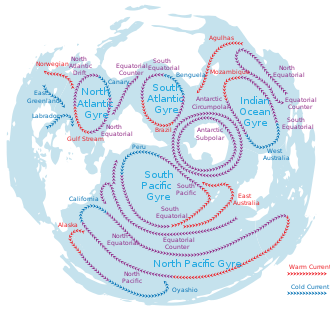
A garbage patch is a gyre of marine debris particles caused by the effects of ocean currents and increasing plastic pollution by human populations. These human-caused collections of plastic and other debris are responsible for ecosystem and environmental problems that affect marine life, contaminate oceans with toxic chemicals, and contribute to greenhouse gas emissions. Once waterborne, marine debris becomes mobile. Flotsam can be blown by the wind, or follow the flow of ocean currents, often ending up in the middle of oceanic gyres where currents are weakest.
Contents
- Identified patches
- Great Pacific
- South Pacific
- Indian Ocean
- North Atlantic
- Environmental issues
- Photodegradation of plastics
- Effects on marine life
- Deposits on landmasses
- References
Within garbage patches, the waste is not compact, and although most of it is near the surface of the ocean, it can be found up to more than 30 metres (100 ft) deep in the water. [1] Patches contain plastics and debris in a range of sizes from microplastics and small scale plastic pellet pollution, to large objects such as fishing nets and consumer goods and appliances lost from flood and shipping loss.
Garbage patches grow because of widespread loss of plastic from human trash collection systems. The United Nations Environmental Program estimated that "for every square mile of ocean" there are about "46,000 pieces of plastic". [2] The 10 largest emitters of oceanic plastic pollution worldwide are, from the most to the least, China, Indonesia, Philippines, Vietnam, Sri Lanka, Thailand, Egypt, Malaysia, Nigeria, and Bangladesh, [3] largely through the rivers Yangtze, Indus, Yellow, Hai, Nile, Ganges, Pearl, Amur, Niger, and the Mekong, and accounting for "90 percent of all the plastic that reaches the world's oceans". [4] [5] Asia was the leading source of mismanaged plastic waste, with China alone accounting for 2.4 million metric tons. [6]
The best known of these is the Great Pacific Garbage Patch which has the highest density of marine debris and plastic. The Pacific Garbage patch has two mass buildups: the western garbage patch and the eastern garbage patch, the former off the coast of Japan and the latter between California and Hawaii. These garbage patches contain 90 million tonnes (100 million short tons) of debris. [1] Other identified patches include the North Atlantic garbage patch between North America and Africa, the South Atlantic garbage patch located between eastern South America and the tip of Africa, the South Pacific garbage patch located west of South America, and the Indian Ocean garbage patch found east of South Africa listed in order of decreasing size. [7]


